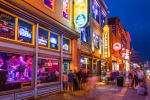When we think of traveling abroad, we often imagine indulging in unique, local experiences—dining in hidden sushi bars in Tokyo, savoring street food in Bangkok, or discovering tucked-away cafés in Paris. Social media has only amplified this desire, with Instagram posts glorifying “authentic” experiences that seem far removed from everyday life. But what if I told you that authenticity could be found in the most unexpected place—a fast-food restaurant?
It might sound strange, but stepping into a McDonald’s or KFC abroad can provide a genuine glimpse into local life. These global chains, often dismissed as symbols of cultural homogenization, are deeply woven into the fabric of daily life in countries worldwide. Visiting them can reveal as much about a culture as a traditional eatery tucked away on a cobblestone street.
The Search for Authenticity
The idea of “authenticity” is often tied to the pursuit of something unfamiliar and untouched by global influence. For many travelers, this means avoiding recognizable brands and instead seeking out places that feel distinctly local. Yet, this perception can overlook a significant truth: global brands like McDonald’s, KFC, or Burger King have become an integral part of life in cities like Tokyo, Accra, or Paris.
In Tokyo, for instance, McDonald’s has been around since 1971, arriving during a pivotal moment in Japan’s modern history. For locals, the opening of the American fast-food chain marked the beginning of a new era. Today, it’s as much a part of Tokyo’s culture as its sushi bars and ramen shops.
Similarly, in Ghana, KFC serves as more than just a fast-food outlet. It’s a space where people gather to work, socialize, or even escape the city’s frequent power outages, thanks to its reliable generators. These establishments have adapted to local needs and preferences, offering a blend of global familiarity and regional uniqueness.
A Local Twist on Global Brands
One of the most fascinating aspects of global fast-food chains is how they adapt to local tastes. In Canada, McDonald’s offers poutine. In West Africa, KFC serves jollof rice. Meanwhile, in India, McDonald’s menus are entirely beef-free, catering to cultural and religious sensitivities, with vegetarian options like the McAloo Tikki burger becoming bestsellers.
These adaptations are not just about catering to taste buds—they reflect how deeply these brands have integrated into local cultures. They are no longer foreign imports but rather part of the everyday life of the communities they serve.
Fast Food as a Window into Local Life
What makes fast food an unexpected but valuable window into local culture is its accessibility. Unlike high-end restaurants or niche eateries, fast-food chains are places where people from all walks of life come together.
When you sit in a McDonald’s in Tokyo or a KFC in Accra, you’re surrounded by locals going about their daily routines. You might see a student typing away on a laptop, a family enjoying a meal together, or an older couple reminiscing over coffee. These moments of ordinary life can offer insights into a culture’s rhythm and priorities.
For instance, in Accra, a conversation with a young man at KFC revealed that he frequented the restaurant not just for the food but also for the free Wi-Fi and a quiet space to work. It highlighted how the brand had adapted to meet the needs of a city grappling with infrastructure challenges.
A Global Monoculture with Local Roots
Fast food is often criticized as the epitome of globalization, erasing cultural diversity with its standardized menus and branding. However, this perspective overlooks how these chains have become “indigenous” to the globalized world. They reflect the blending of local and global influences, where a Big Mac in Paris or Tokyo might feel both familiar and distinct.
This duality is what makes fast food a fascinating lens through which to view a culture. It’s a reminder that globalization doesn’t erase cultural uniqueness—it reshapes it in unexpected ways.
Finding Meaning in the Mundane
Visiting a fast-food restaurant might not seem like the most exciting way to explore a new country, but it offers a unique kind of authenticity. It’s a chance to step into the everyday lives of locals, to see the world through their eyes, and to understand their challenges and aspirations.
By engaging with people in these spaces—asking about their favorite menu items or striking up a conversation—you can gain a deeper understanding of the culture. It’s a way to connect with others, not as a tourist seeking novelty, but as a fellow participant in the shared experience of modern life.
Why You Should Give It a Try
Next time you’re traveling, consider stopping by a McDonald’s, KFC, or similar chain. Look beyond the golden arches or the familiar red bucket and see them for what they are—spaces where culture, commerce, and community intersect.
Order something unique to the region, strike up a conversation with a local, or simply observe the flow of life around you. You might be surprised by what you discover.
In a world increasingly shaped by global capitalism, fast food can offer an authentic glimpse into the ordinary—and extraordinary—lives of people worldwide.
Disclaimer – Our editorial team has thoroughly fact-checked this article to ensure its accuracy and eliminate any potential misinformation. We are dedicated to upholding the highest standards of integrity in our content.





More Stories
Exploring Global Culture Through the Lens of Fast-Food Restaurants
Exploring Global Culture Through the Lens of Fast-Food Restaurants
Exploring Global Culture Through the Lens of Fast-Food Restaurants